They say that beauty lies in the details, and harmony consists of individual details. Napkins for plates are a vivid confirmation of this, being a practical and aesthetically attractive element of the arrangement of the kitchen. The material in this article will tell readers about what these products are and what are the main criteria for their selection.
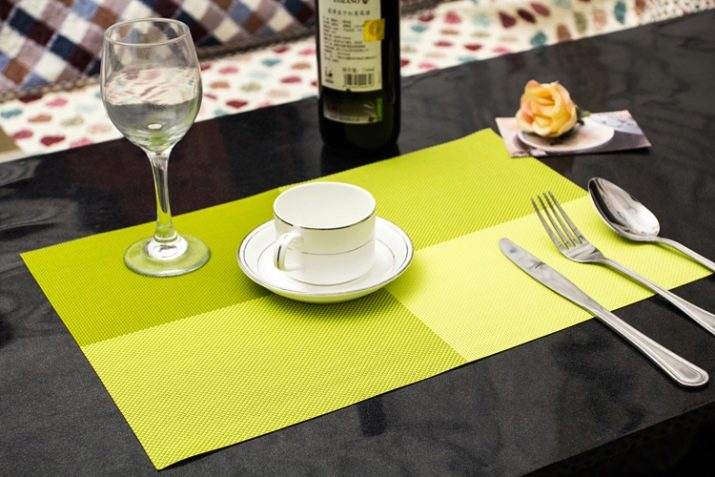
What are coasters for?
Napkins for dishes are one of the key elements in the arrangement of everyday life. Today, they not only save the countertop from premature aging, but also from various kinds of damage. These are tools for the care of kitchen furniture, they can be put under hot dishes on the table. They save tables and cooking places from dirt and stains, make a clear organization in the meal, limiting the space of everyone sitting at the table.
Besides the fact that they are placed under plates, they are suitable to put a kettle, cups, glasses on them. They substantially decorate the table when serving it. Depending on the type of product, it can be used for pots and pans (including portioned varieties), as well as ceramic pots. Moreover, the products differ in heat resistance and insulating properties. In most cases, they are also designed to provide anti-slip, and therefore tightly fit to the work surface.
Besides, coasters are also needed for cold dishes. Sometimes during meals, in addition to plates, glasses with chilled drinks are placed on them, which in warm rooms leads to wetting of the countertops. Such napkins are not afraid of moisture, they do not pass it.Also, among other analogues, there are decorative options, the purpose of which is the exclusive decoration of the festive table.
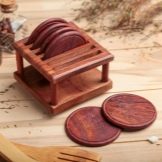
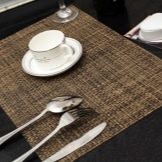
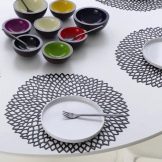
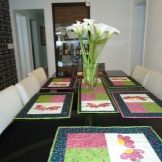
Features
Thanks to the modern approach to creating various kinds of kitchen accessories, plate stands today can be different. Moreover differences can occur not only in the type of material used in the production. Other products differ in other ways. For example, some of them are independent elements, others are included in the package with supports for cups and pots.
The second options are convenient in that they create a large share of comfort against the general background of the interior. The first ones have to be selected more carefully, based on the type of dishes available and the method of use. Depending on what they are made of, products can be designed for different types of use. For example, some of them are suitable for hot dishes, while others are not designed for this.
Products may vary in size and shape. This allows you to choose the option taking into account your own preferences, corresponding to a certain style of the interior in which the kitchen is made. However, such napkins can be selected not only for the kitchen. Manufacturers offer customers the widest range of these accessories.
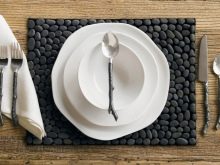
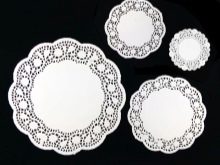

In their lines you can find serving options that can decorate the dining room, living room, tea and coffee tables. They are great for arranging gazebos, decorate tables for room decoration in special occasions.
Depending on the material of manufacture, they may differ in thickness and density., which is why some of them completely protect the countertop from the hot, while others cope with this task only partially.
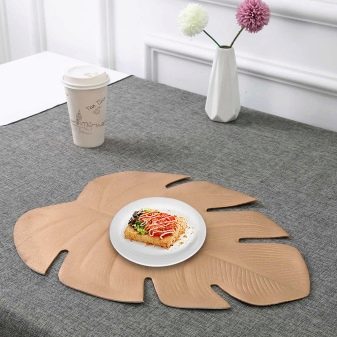
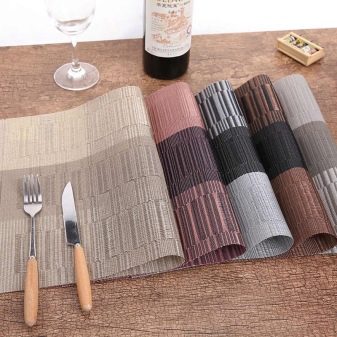
Varieties
According to the type of performance, the products can be very diverse. For example, in a classic form it is most often monolithic type products, or even mats for dishes. This category includes homemade options crocheted like traditional rugs. It can also be textile options made of dense natural material that does not melt and can protect the table surface from hot dishes.
Based on the type of material, models may have different performance characteristics. For example, some of them are anti-skid, which is very good when used in the kitchen. Others are convenient in that they have a certain weight. Due to it, they are stable, while some models can be accidentally swiped from the table.
Still others are comfortable in that in addition to the usual working surface, they have various kinds of functional additions. For example, it can be pockets for forks, spoons and knives, as well as additional miniature napkins for cups or teapots. In addition, this line includes options with napkin loops designed for wiping after eating.
Particular attention should be paid to compositional products designed for small tables. They can consist of four napkins folded into one product. In addition to them, analogues in the form of small islands-trays are worthy of attention. They are not only extremely aesthetically pleasing, but also contribute to the organization of the meal.
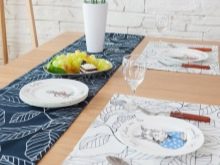

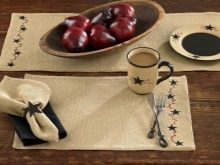
The type of use of the plate stands may vary. Some of them provide for daily operation, others can be designed for holidays. Still others are completely disposable, and therefore do not require any care. The fourth ones are used as protection of the glass surface from stains and scratches, and therefore they are selected with special care.
Fifths are necessary, like mobile thermo-wipes, when households want to protect the surface of the place of the meal from exposure to high temperature or moisture and stains. Customers also use some products as tacks.Others perform two functions at the same time and are needed where table oilcloths lie on the tables (they prevent sintering of the material and protect the dishes from slipping).
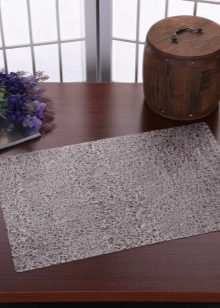
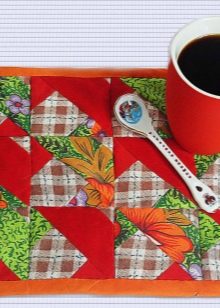
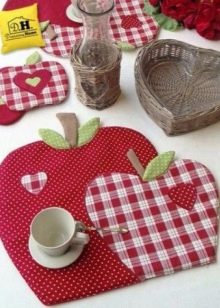
Materials
Napkins for plates are made of different raw materials, due to which the products are not only different in degree of heat resistance, but also resistant to cuts, punctures, which may result from careless handling. For example, on the shelves of modern stores you can buy napkins for dishes:
- bamboo;
- silicone;
- plastic;
- paper;
- leather;
- wooden;
- cork;
- textile.
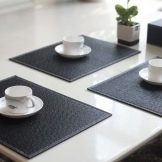
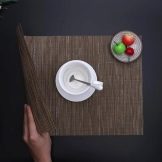
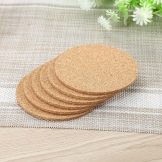
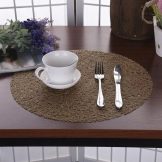
The most impractical but convenient products are paper options. Despite the fact that they are disposable, they perfectly help users in nature, during a meal on a camping trip or in other non-standard situations. They do not save the surface of the table from moisture and stains, however, they increase the level of user comfort.
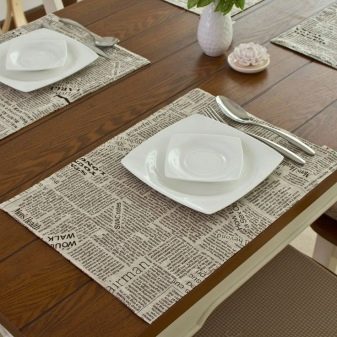
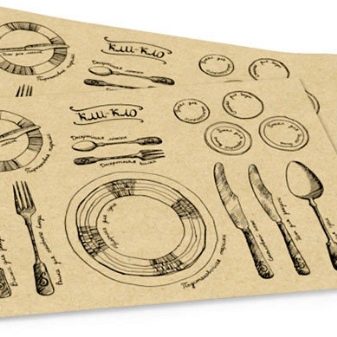
Wooden coasters in this regard are more perfect. Often they can have a design that provides air access from below, due to which the dishes placed on them cools faster. However, in some models, as practice shows, hot water can form on the bottom of the plate, which gets on the table and spoils the furniture.
If this product is made of saw cuts, it is important to ensure that they are not glued with harmful glue.
When heated, such a stand will emit toxins. In addition, not all types of wood can withstand contact with hot wood. The best options for wood are those made of red rosewood, oak and juniper. They are not afraid of contact with hot, and some of them emit aromatic oils.
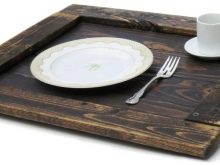


Cork coasters for hot plates are good because they are not afraid of moisture and sufficiently insulate the working base from high temperature. Their disadvantages are crumbling and brittleness. However, a plus of models from cork can be called a different type of decorativeness. For example, they may have a laminated coating on one side. Such products are sold in complete sets for 6 people.
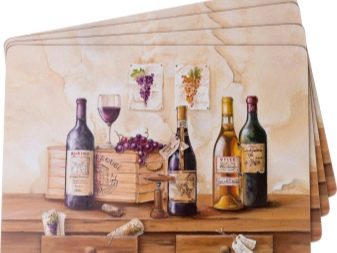
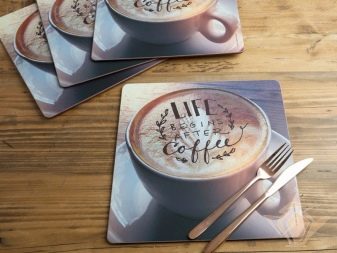
Wicker options are made from willow vines. They look unusual and fit perfectly into such areas of interior design as retro, rustic or country. Bamboo napkins can be collected from fragments of stems, these mats are not afraid of moisture or mold, if necessary, they can be rinsed in water. Depending on the model, they can be traditional or reinforced (supplemented with metal inserts).
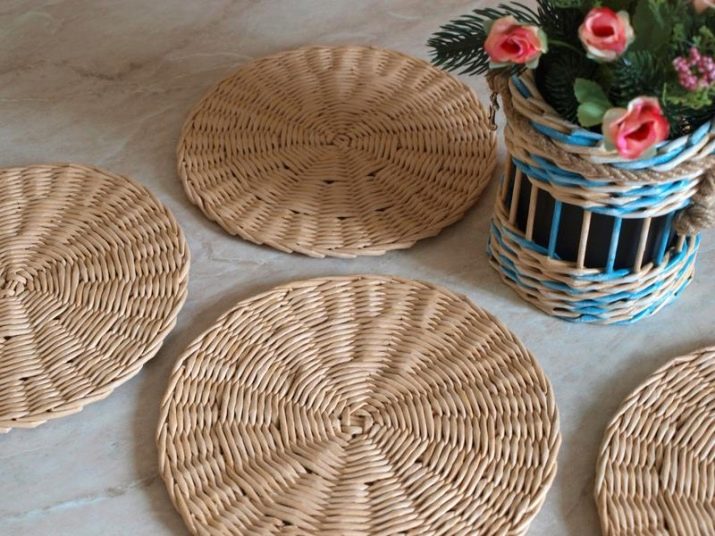
Manufacturers also use plywood in the manufacture of plate stands, cutting out sometimes bizarre shapes from it. A considerable part of such products is decorated using the technique of burning. The forms themselves can be either monolithic or glued from identical fragments. Silicone molds for plates are convenient in that they stick tightly to the surface of the countertop and do not allow the plates or other dishes on them to move. Homemade coasters can be made of different improvised material: for example, it can be twine or vinyl records. In addition, they can be openwork and knitted. Vinyl and PVC are bad because they fade in the sun. Silicone also tries to maintain integrity, and therefore serves longer.
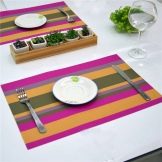


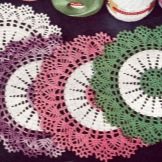
Design
To date, manufacturers have managed to find an approach to any buyer. Napkins for plates can be made not only in different forms - they are often “sharpened” for a specific style. For instance:
- for environmental styles, these can be plant prints in the form of leaves, tree branches;
- for ethnic design branches, trademarks offer products with ornaments of various mottles and themes;
- connoisseurs of classics manufacturers will please with a design using lace and gilding;
- for fans of minimalistic solutions, companies produce plain products of concise shapes;
- Adherents of everything bright and unusual will like creative products, through which the interior acquires a special “zest”.
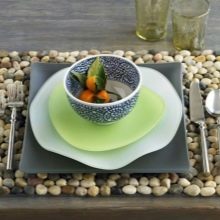
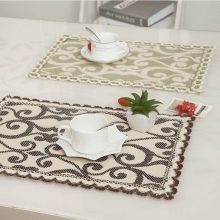
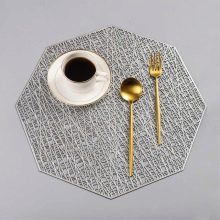
Noteworthy prints for the newspaper or antique watches that will be in place in the style of retro. No less relevant options with design for Moroccan patterns, Chinese painting, monograms and floral ornaments. Some people like rimmed products; others prefer to buy napkins with an asymmetric design. Products of this type sometimes clearly indicate the area under the plate and the place under the forks, spoons or knives.
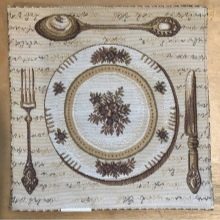

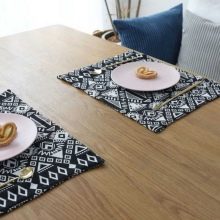
Variety of shapes
Today, manufacturers surprise customers not only with colors and thematic prints of napkins and plate holders. In the arsenal of manufacturers there are many tricks to expand the customer base, and it is the form that becomes one of the key aspects. It can be concise and familiar or complex and artsy. For example, simple variants include products in the form of a rectangle, which can be very small or large, reaching in size up to 60–90 cm.
Besides them, supports can be round, oval, trapezoidal, in the form of a rhombus, square. At the same time, the complexity of the form can be manifested in its design: for example, if some products are simple and more like mats, others resemble stands on legs that have holes in the center (in the form of a contour of a geometric figure or, for example, a house). Single-layer options can be made in the form of fruit, animal, bird. Moreover, products of a certain type, as a rule, are subject to specific color schemes.
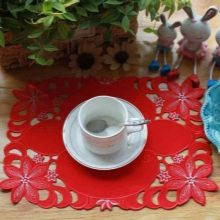
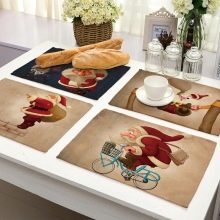
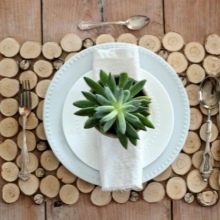
Products can have a single form for several people. For example, it can be cruciform with a common middle. Such modifications can be placed under the plates on a small table. Other products are more like strips that are used as practical and decorative, decorating them with a table for a gala reception. In addition to plates, they put spoons, knives, forks, put cups. Others are often complemented by coasters for teapots.
How to choose?
When buying one or another version of the plate stand, you have to take into account a number of nuances. For example, it is important to immediately determine how it is planned to use the product.
If, for example, it will be used for plates and other utensils, this makes you think about buying a larger option. Moreover, you will have to buy several products at once, so that together they make up a harmonious lunch set.
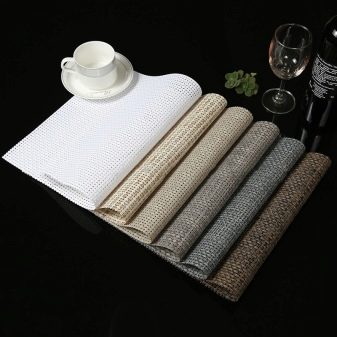
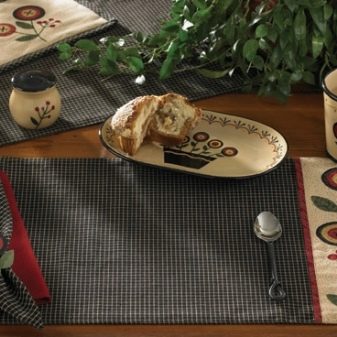
If you only need napkins for plates, their size will be smaller. But it is necessary to take into account the type of material. The product should not deteriorate from contact with hot, it should not transmit heat to the countertop. Paying attention to the material of manufacture, it is worth noting for yourself:
- whether its thickness is sufficient;
- whether he can protect the surface of the countertop from mechanical damage;
- will simplify the care of her;
- whether to slip along with the dishes;
- Does it have the indicated quality?
- Does it emit harmful and unpleasant odors;
- worth the money and how long it can last.
When choosing, you must pay attention to the color scheme of the product, correlating it with the existing background color of the interior. It is important that the design does not get out and corresponds to the specific style in which the room with the table is decorated (kitchen, living room combined with the dining room, bay window, attic, gazebo).
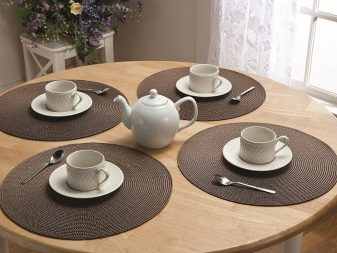
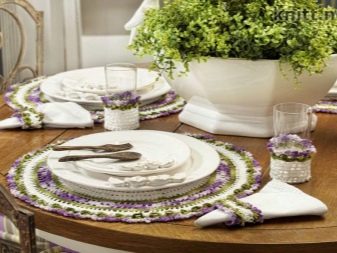
For example, for laconic branches of stylistics (minimalism), options without a picture and complex decor are suitable. For classics, decorations, delicacy and gilding are needed.
When choosing a product, it is the style of the interior that can suggest the type of best material, as well as its texture. For example, for Art Nouveau, Art Deco or brutalism, options from modern materials are needed, and with a noble texture. For example, it can be silicone or plastic, with gloss or matte, but not wood or textiles.If wipes are needed for country or provence styles, woven products are needed here, and models with an openwork edge and a floral print are welcome.
It is important to pay attention to the size of the room - this will allow you to understand the size of the stands and the desired degree of their snug fit to the working base.
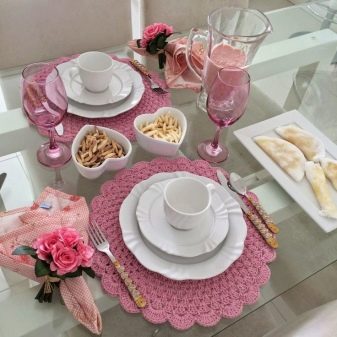

For example, in small kitchens, the best option is to use silicone napkins for hot dishes. They will not allow either plates or cups to move off the table, they will not go on it if they are accidentally grazed. Silk analogues of the decorative plan are inappropriate here.
When buying, you need to pay attention to the price, correlating it with quality. It is important to look not so much at the manufacturer’s brand as at quality characteristics. For example, cheap plastic or poorly glued wood emits specific odors. If such coasters are placed under hot dishes, toxins harmful to the human body will begin to stand out from them. Wooden models should be dense, moderately heavy, without cracks and black spots, good plastic weighs slightly heavier than cheap, and its external characteristics are much better.
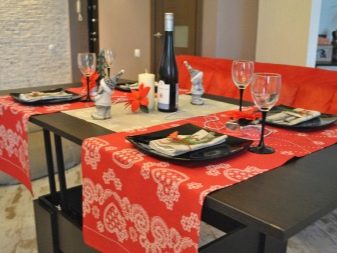
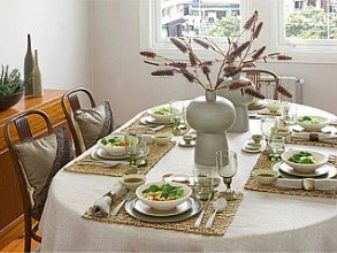
See how to make a vintage plate holder using decoupage technique in the next video.










